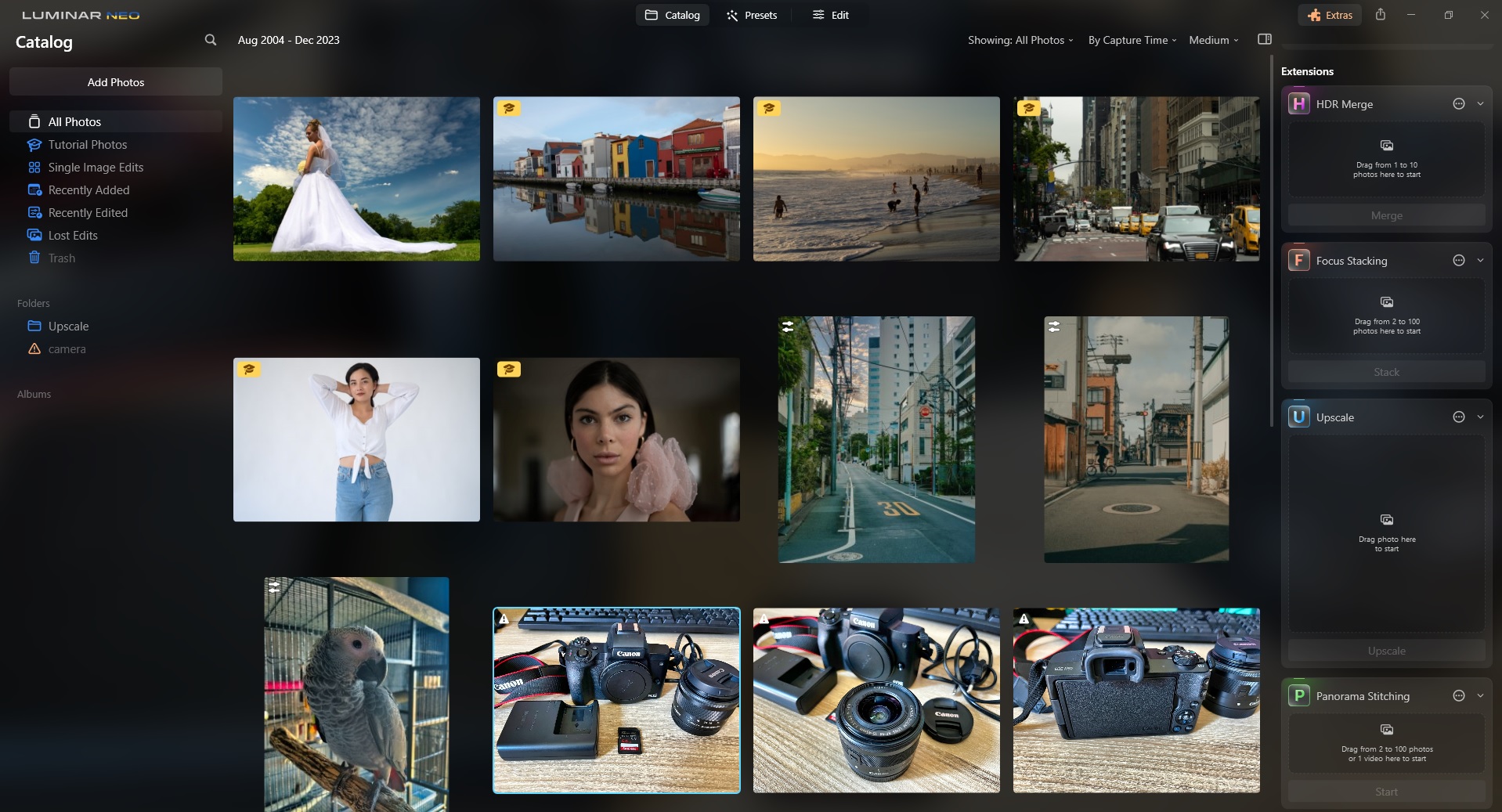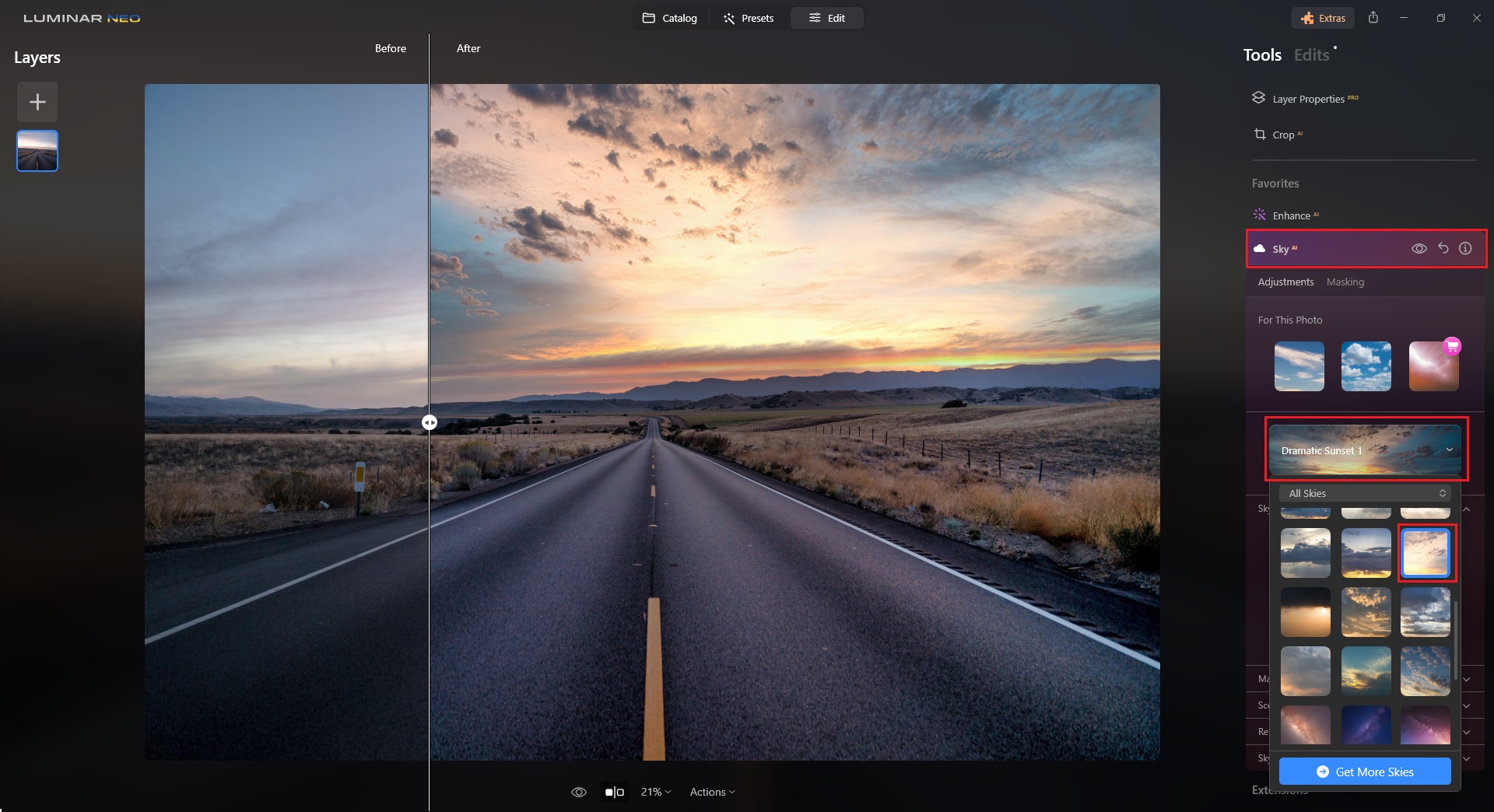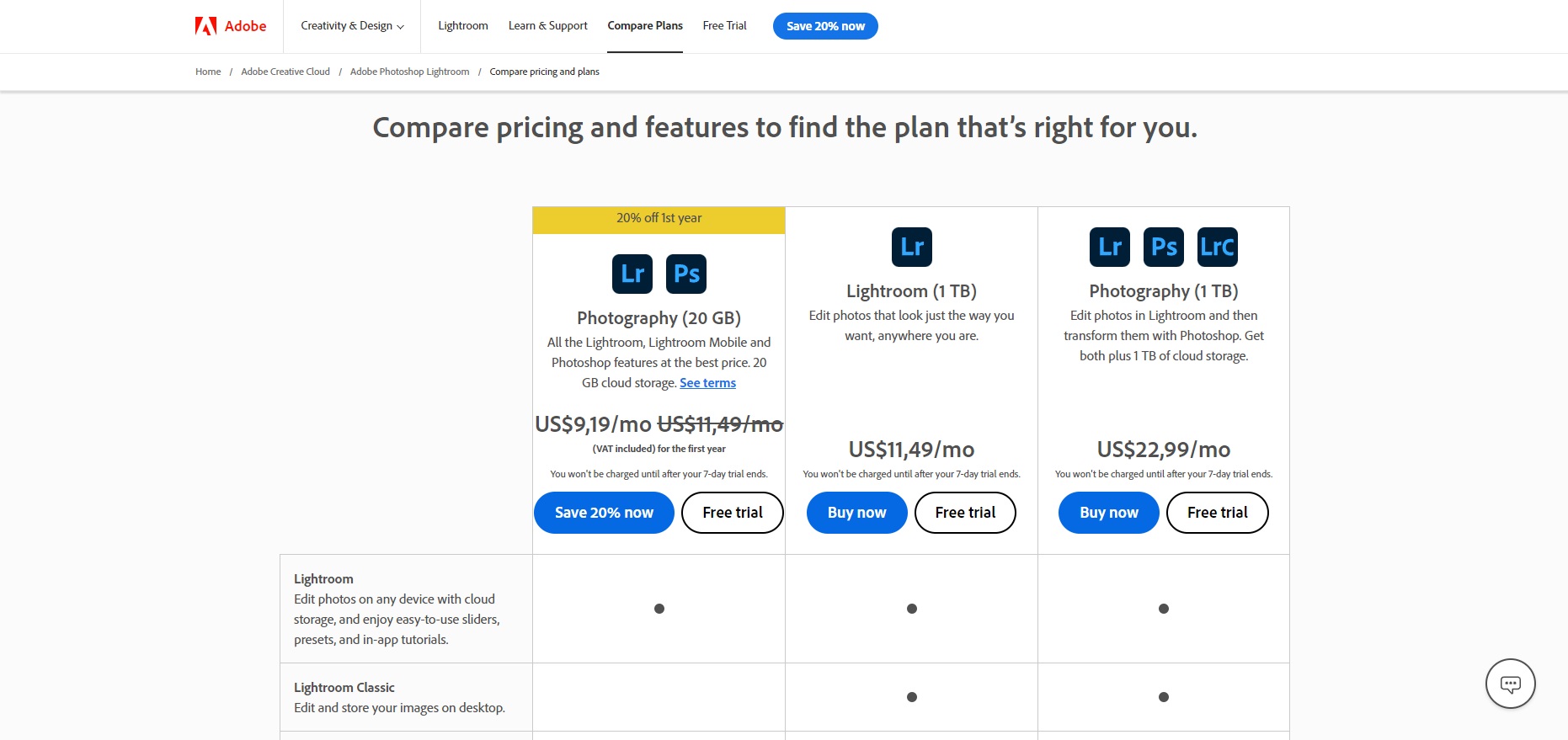Hey, fellow creatives! Today, let’s dive into the ultimate clash of the titans in the photo editing world: Luminar Neo vs Adobe Lightroom. Each of these software solutions offers distinctive capabilities, designed to meet the diverse needs of both novices and seasoned professionals.
As a designer always on the lookout for the perfect blend of power and finesse, I’ve taken these two for a spin, and boy, do they each bring their own bag of tricks to the table.
Within this extensive guide, we will delve into the strengths and considerations of each software, providing insights from the viewpoint of photographers aiming to elevate their images.
Table of contents
Adobe Lightroom has long been a staple in the photography community, recognized for its robust editing capabilities, organizational tools, and seamless integration into the Adobe Creative Cloud ecosystem.
On the other hand, Luminar Neo, developed by Skylum, aims to disrupt the market with innovative features and a user-friendly interface.
Since Adobe decided to switch to a subscription platform, more and more creatives decided to look elsewhere for better solutions.
One of these solutions has stand out even more than the rest. Sklyum’s award-winning Luminar Neo editing app!
Picking between Lightroom and Luminar Neo should be based on factors such as your skill level, workflow preferences, the type of photos you intend to edit, and the extent of photo editing you desire.
I will be testing Luminar Neo and Lightroom Classic and will go through their major features ????
If you want a TLDR of this comparison, check out this table:
| Feature | Luminar Neo | Adobe Lightroom |
| Ease of use | Easy | More complex |
| AI-powered tools | Comprehensive | Limited |
| Photo editing features | Wide range | Wide range |
| Professional workflow tools | Limited | Comprehensive |
| Price | $9.95/month or $199 for a lifetime license | $20.99 per month or $239.88 per year |
Luminar Neo vs Adobe Lightroom
⚙️ Ease of Use
When it comes to the interface, right out of the bat you can see a major difference.
Lightroom’s user interface, while comprehensive, can be intimidating for beginners. However, its familiar layout to Adobe users facilitates a smooth transition. Luminar Neo, designed with simplicity in mind, offers a more intuitive interface, making it accessible to users with varying levels of editing experience.

Luminar Neo’s UI is simple and has a lot of breathing room. It’s not overwhelming the first time you look at it compared to other types of software.
As a beginner, you can even use it intuitively, without the help of tutorials.
The three main workspaces are Catalog, Presets and Edit which you can easily navigate in between by clicking on the top of the screen.
Accessing the advanced tools is straightforward, thanks to their user-friendly names that clearly indicate their intended outcomes. Additionally, each tool is accompanied by a description detailing its functionality.
On the other hand, Lightroom’s UI is more complex and has a pretty steep learning curve. A complete beginner will feel overwhelmed and most likely decide not to use it anymore.

Understanding the Lightroom catalog feature requires a learning curve, and watching tutorials is essential to grasp how the software handles image management and organization.
Navigating the editing tools in Lightroom can be overwhelming, given the multitude of buttons and sliders. Despite using it for years, I still feel like I’ve only explored a fraction of Lightroom’s full potential.
Ease of use department: The winner is Luminar Neo!
⚙️Editing
Both Luminar Neo and Lightroom Classic offer a mix of basic and advanced photo editing tools. However, they have different strengths and weaknesses.
Common adjustments like tone, contrast, HSL, vibrance, and white balance are readily accessible in both programs, a standard feature in many major photo editing software.
However, Luminar Neo focuses on streamlining workflow, particularly for casual photographers.
They’ve invested significant effort in creating AI filters, with the standout being AI Sky Replacement. This nifty tool lets you change entire skies in your photos with just one click, leaving you in awe every time you use it.

When contemplating the choice between Luminar and Lightroom, I consistently advise examining one of Luminar’s standout features: its one-click editing capability.
Both Luminar Neo and Lightroom have a wide range of photo editing features, including:
- Basic adjustments: Exposure, contrast, highlights, shadows, whites, blacks
- Color adjustments: White balance, hue, saturation, vibrance
- Detail adjustments: Sharpening, noise reduction
- Lens corrections: Vignetting, distortion, chromatic aberration
- Creative tools: HDR merge, panorama stitching, focus stacking
If you’re familiar with Photoshop, you understand the potency of its layer-based editing feature. Layers allow you to overlay edits, selectively remove adjustments, apply masks, and perform various other functions.
While Lightroom lacks layer-based editing, Luminar steps in to fill this void.
Luminar introduces the capability to make adjustments on distinct layers, enabling selective application of these adjustments. This involves masking out specific areas of the layer, ensuring that only designated parts of the photo undergo enhancement through sliders or corrections using tools.
Editing department: Both programs are solid!
⚙️General Performance
Talking about how these photo wizards perform, Lightroom Classic used to be a bit of a slowpoke.
Over the years, Lightroom has significantly improved its performance in response to user feedback.
The introduction of Lightroom Smart Previews has notably accelerated workflow, creating smaller “mini RAWs” that are more manageable for the software. Users can work seamlessly across desktop and mobile platforms, and while some users still find Lightroom to be a bit sluggish with extensive edits, Adobe continues to enhance its performance.
But, truth be told, Lightroom still has some hurdles to jump for ultimate speed. Users are crossing their fingers for a makeover, but that might take a while.
Now, let’s talk Luminar Neo. Switching between its different modules is snappy – way better than Lightroom’s old stumbles.
Luminar Neo prides itself on a snappy performance, especially when switching between various modules. However, users may experience a slowdown when utilizing AI tools, with adjustments and strength controls taking a few seconds to load.
Recent updates have optimized Luminar extensions to leverage the computer GPU, promising potential performance boosts in future main app updates.
To make sure that your computer can handle these two software, here is a breakdown of their minimum system requirements:
| Feature | Adobe Lightroom | Luminar Neo |
| Processor | Intel® or AMD processor (2 GHz or faster with SSE 4.2 or later and 64-bit support) | Intel® Core™ i5 or better, AMD Ryzen™ 5 or better |
| Operating system | Windows 10 (version 22H2) or Windows 11 (version 21H2 or later) | Windows 10 version 1909 or higher (only 64-bit OS) |
| RAM | 8 GB, 16 GB or more recommended | 8 GB RAM or more (16+ GB RAM is recommended) |
| Hard disk space | 4 GB of available hard disk space; additional space is required for installation | 10 GB free space |
| Graphics card | GPU with DirectX 12 support; 2 GB of GPU memory | Not specified |
| Monitor resolution | 1024 x 768 display, 1920 x 1080 display or greater | 1280 x 768 display |
General performance department: Lightroom takes the win!
⚙️ Pricing and Value
Now, let’s dive into the money talk – the difference in how Luminar and Lightroom handle your cash.
Adobe’s Creative Cloud subscription feels like a wallet-drainer, especially for the casual photographers.
It’s like committing to a never-ending relationship with monthly payments and everyone can see why more and more people try to look for alternatives.

On the Lightroom front, the only ticket to entry is through a subscription, be it on a monthly or yearly basis. Discontinuing the subscription means losing access to Lightroom.
Furthermore, if you’re still clinging to the last non-subscription version, Lightroom 6, you’re missing out on the latest and greatest features, and compatibility with the newest macOS may be in jeopardy.

In contrast, Luminar Neo adopts a more flexible approach, less monthly payments, and offers a one-time purchase option, along with discounted future updates for existing Luminar users.
The lifetime price is $199 and compared to Adobe’s subscription plan, it’s totally worth it. You pay once, you have it forever.

Pricing and value department: Luminar neo comes out on top!

Considerations
Integration with Existing Workflows
Lightroom’s seamless integration with the Adobe Creative Cloud ecosystem is a significant advantage for users who are already accustomed to Adobe’s suite of tools. If you’re heavily invested in other Adobe applications such as Photoshop or Illustrator, Lightroom may provide a more cohesive workflow.
Luminar Neo, while a powerful standalone tool, may not integrate as seamlessly with other software outside the Skylum ecosystem. Users relying on a variety of applications in their editing process should consider how well Luminar Neo fits into their existing workflow.
Learning Curve
Lightroom’s interface, while comprehensive, can be initially overwhelming for beginners. However, its structure is designed to guide users through a logical workflow, making it easier to learn with consistent use. Those already familiar with Adobe’s interface will find it more intuitive.
Luminar Neo, with its emphasis on simplicity and user-friendly design, offers a shorter learning curve. Users new to photo editing or those who prefer a more intuitive interface may find Luminar Neo more accessible.
Community and Support
Lightroom boasts a vast and active user community. The abundance of online tutorials, forums, and resources makes it easier for users to find solutions to problems or discover new techniques. Adobe’s extensive support network adds to the appeal.
While Luminar Neo is gaining popularity, its community may not be as extensive as Lightroom’s. Users who heavily rely on community-driven support and tutorials may want to consider the existing ecosystem around each software.
Platform Compatibility
Lightroom’s compatibility across various platforms, including Windows, macOS, iOS, and Android, ensures a consistent experience for users working on different devices. This cross-platform compatibility is particularly beneficial for photographers who edit on both desktop and mobile.
Luminar Neo also offers cross-platform compatibility, but users should verify the extent of features and performance on different devices. As the software evolves, improvements to mobile and desktop versions are likely.
Advanced Editing Needs
Lightroom’s comprehensive editing tools cater to a wide range of users, but for those with highly advanced editing needs, especially in areas like retouching and intricate adjustments, they may find Photoshop, which is seamlessly integrated with Lightroom, more suitable.
Luminar Neo’s focus on AI-powered tools and layer-based editing provides a unique advantage for users with creative and advanced editing requirements. The flexibility of layers allows for more nuanced adjustments, making it suitable for those seeking advanced editing capabilities without necessarily transitioning to Photoshop.
Wrapping up…
Choosing between Adobe Lightroom and Luminar Neo ultimately depends on your specific needs and preferences. Lightroom remains a robust choice for those deeply ingrained in its workflow, especially with its comprehensive organizational tools and cloud integration. On the other hand, Luminar Neo appeals to users seeking innovation, AI-powered tools, and a more flexible editing process with layer-based editing.
For those already familiar with Lightroom’s workflow, I suggest considering the purchase of Luminar as well. Integrating both software options can be a strategic move, as it allows users to capitalize on the unique strengths of each program in tandem.




